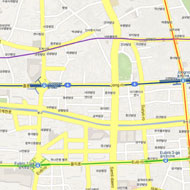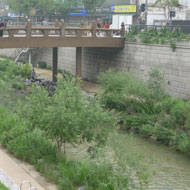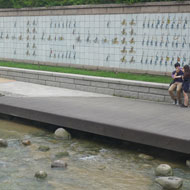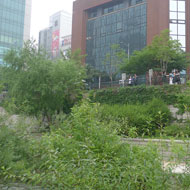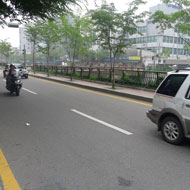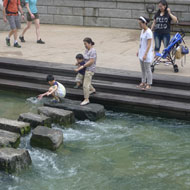Background
Cheong Gye Cheon is a dramatic transformation of a site with more than a 5 mile long concrete roadway with an elevated highway into a vibrant public recreation open space running that serves the old central business district area of Seoul. More than a century ago, the Cheong Gye Cheon (CGC) was called Gaecheon or "open stream" and served as a major water resource for its neighborhoods. During the 1950s and 60s, the urbanization of the city and increasing industrial development polluted the stream and it was covered with concrete roads. Soon, an elevated highway was built to meet the increasing high transportation demand for the heavily industrialized city center. In the 1980s, the impacts of the highway and effect to the economic decline of the central areas became clearly recognized. People began to be concerned about air pollution from the highway, health risks from unsanitary conditions and a decreasing stability of the aging infrastructure. A group of academics and environmentalists developed a community-based master plan for demolishing the 10-lane highway and restoring the stream. In 2002, Seoul Metropolitan Government established an organization to move the project forward.
By 2003, the freeway had been completely disassembled. The restored CGC stream and the linear park were opened to the public in October 2005. The greening of central Seoul created a great amount of public amenities, but this resulted in a significant loss in road capacity. To relieve possible traffic congestion impacts, the Seoul Metropolitan Government improved the public transit system. The city opened 40 miles of dedicated rapid-bus lanes along major arterials. In 2004, the city reconfigured bus routes to feed more effectively into the city’s subway system (Kang and Cervero 2009). As a result, the daily traffic volume of the CGC area, which was about 168,556 in 2001, had decreased. In 2006, the bus and subway ridership of the inner city had increased by 11% and 13.7% respectively (Park 2007).
Project Description
- The project took about 27 months to construct and cost about $346 million. It involved the demolition of 3.4 miles of elevated structures which helped in the formation of a new 3.5 mile long watercourse and river bed. The construction of 22 new bridges dramatically improved the overall multi-modal mobility across the corridor. Overall, over 3.6 miles of the corridor has been landscaped. The landscape design concept took into account the creation of three different sectors, each with its own cultural theme: The upstream section represented history and tradition, the midstream represented culture and modernity and the downstream section represented nature and future. The average project cost per sector was estimated to be about £60 million. Landscaping focused on providing a balance between improving urban ecology and public access. The northern side of the river provides seating and strolling areas for people, while the southern side is designed for plants and wildlife. Small squares, public art works and waterfront decks are located at regular intervals along the river.
- Reduces urban heat island effect (Noh 2006).
- Increases open space and recreational opportunities in the civic center area.
- Enhances tourism in the central business district. In the first three months following its restoration, a quarter of all Koreans—about 10 million people—visited the river.
- Enhances the pedestrian experience: While the design created a wide variety of pedestrian amenities including sidewalks and nighttime lighting, the edges of the revitalized green corridor has attracted new pedestrian friendly uses, especially in buildings adjacent to the river which have become restaurants and cafés, providing food and seating for pedestrians.
- Increases wildlife habitat in the urban area.The number and range of birds, insects and fish now living in and around the river are on the rise.
- Enhances economic vitality.The land values around the green space have increased, and large-scale reconstruction and redevelopment projects are now being undertaken along the whole corridor.
- Recycles the demolished structures. The total weight of the demolished structures was 907,000 tons, including 79,000 tons of concrete, 82,000 tons of asphalt concrete and 35,000 tons of steel. Around 96% (839,000 tons) of concrete and asphalt concrete was recycled, mostly as sub-base material for road construction. All reinforcing steel was sent to mills for recycling (Shin and Lee 2006).
- Traffic congestion concerns: There were strong community concerns about traffic congestion caused by reduction in highway capacity. The traffic congestion issue was dealt with by introducing a new multi-modal transportation policy and with a strong focus on public transport.
- Construction delay: During the rainy season, the river flooded within 30 minutes. This caused many constraints to riverbed work and led to construction delay.
- Economic loss to businesses during construction work: Due to the extent and length of construction time, there was some economic loss to existing businesses during construction. To minimize the construction impacts, the City provided a stability fund to facilitate relocation. To enable this, the project team held around 4,000 meetings with residents, either individually or in groups.
Adopted from: Shin and Lee 2006
While the restoration of CGC increased the amount of green space and provided east-west walk paths in the central city, the reduction of the road width and the elimination of the highway greatly improved north-south connections for pedestrians. Moreover the improved public transit systems made trips to central business district destinations easier and faster. A total of 22 vehicle and pedestrian bridges were built across the restored river at the locations of all existing intersections and crossings. This included the restoration of the old Gwang-Tong bridge that had been buried under the highway structure for four decades. The dimensions of bridges vary from 65 feet to 380 feet long and from 85 feet to 193.5 feet wide.
Prior to the highway demolition, many small shopkeepers and merchants who had stores alongside the highway opposed the project out of fear of losing business. Through a intensive negotiation process, the Seoul Metropolitan Government was able to proceed with the plan by financially compensating merchants and relocating a number of shops to a newly constructed market center. As demolition was carried out in a densely populated and trafficked area, it was vital to keep dust and noise to a minimum as well as minimize disruption to traffic. Structures were cut to maximum sizes to reduce the number of transport movements, and they traveled mostly at night. After opening the park, to encourage community participation, a wall of hope program was developed. The participants wrote their wishes on a 100 mm by 100 mm ceramic tile, which was then permanently bonded to one of the embankment walls. More than 20,000 people took part.
The original width of the stream was kept and the bed was lowered to prepare for potential floods. The outer parts of the previous road deck were also retained to carry a new two-lane side road and to allow space for flood flows underneath. A new sloping embankment wall was then built alongside. The final river cross-section varies from 65 feet wide upstream to 380 feet downstream. Low-level terraces have been built along both sides of the river to provide people and wildlife easy access to the water.
One of the most controversial issues was supplying a sufficient amount of water to the restored CGC. It was finally decided to provide a daily supply of 1,006,370 bbl, which would maintain an average depth of 1.3 feet and average current velocity of 0.25 m/s. The water supply consists of 838,640 bbl from the Han River and 167,730 bbl of groundwater infiltration. In addition, the design had to take into account the risk of wastewater and polluted rainwater runoff overflowing into the river during storms because the Cheong Gye Cheon area has a combined sewage system. Large sewers have thus been built alongside the river to provide additional retention for stormwater and to protect its newly established ecological system.
Lessons Learned
Potential Benefits:
Potential Issues:
Sources
Kang, C. and Cervero, R, 2009. “From Elevated Freeway to Urban Greenway: Land Value Impacts of the CGC Project in Seoul, Korea.” Urban Studies 46(13) 2771-1794
Noh, S., 2006. “Cheonggyecheon Restoration In Seoul” Presentation at Minato Water Meeting, Tokyo, Japan
Park, K., 2007. National Archives & Records Services (http://contents.archives.go.kr/next/content/listSubjectDescription.do?id=006448&pageFlag=A)
Shin, J. and Lee, I., November 2006. “Cheong Gye Cheon restoration in Seoul, Korea,” Civil Engineering 159 Pages 162–170 Paper 14775
Photo Sources
MIG, Inc.

